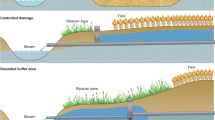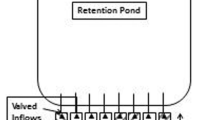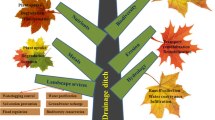Abstract
Agricultural non-point sources of nutrients and sediments have caused eutrophication and other water quality issues in aquatic and marine ecosystems, such as the annual occurrence of hypoxia in the Gulf of Mexico. Management practices have been implemented adjacent to and in agricultural drainage ditches to promote their wetland characteristics and functions, including reduction of nitrogen, phosphorus, and sediment losses downstream. This review: (1) summarized studies examining changes in nutrient and total suspended solid concentrations and loads associated with management practices in drainage ditches (i.e., riser and slotted pipes, two-stage ditches, vegetated ditches, low-grade weirs, and organic carbon amendments) with emphasis on the Lower Mississippi Alluvial Valley, (2) quantified management system effects on nutrient and total suspended solid concentrations and loads and, (3) identified information gaps regarding water quality associated with these management practices and research needs in this area. In general, management practices used in drainage ditches at times reduced losses of total suspended solids, N, and P. However, management practices were often ineffective during storm events that were uncommon and intense in duration and volume, although these types of events could increase in frequency and intensity with climate change. Studies on combined effects of management practices on drainage ditch water quality, along with research towards improved nutrient and sediment reduction efficiency during intense storm events are urgently needed.





Similar content being viewed by others
References
Alexander RB, Smith RA, Schwarz GE et al (2008) Differences in phosphorus and nitrogen delivery to the Gulf of Mexico from the Mississippi River basin. Environ Sci Technol 42:822–830
Amatya DM, Gilliam JW (2003) Effects of orifice-weir outlet on hydrology and water quality of a drained forested watershed. South J Appl For 27:130–142
Baker BH, Kröger R, Brooks JP et al (2015) Investigation of denitrifying microbial communities within an agricultural drainage system fitted with low-grade weirs. Water Res 87:193–201
Baker BH, Kröger R, Prevost JD et al (2016) A field-scale investigation of nutrient and sediment reduction efficiencies of a low-technology best management practice: low-grade weirs. Ecol Eng 91:240–248
Bouldin JL, Farris JL, Moore MT, Cooper CM (2004) Vegetative and structural characteristics of agricultural drainages in the Mississippi Delta landscapes. Environ Pollut 132:403–411
Burchell MR, Skaggs RW, Evans RO et al (2007) Addition of organic matter to agricultural ditch soils to be used as constructed wetlands for nitrate treatment. ASCE, world environmental and water resources congress 2007: restoring our natural habitat
Carter LM, Jones JW, Berry L et al (2014) Chap. 17: Southeast and the Caribbean. In: Melillo JM, Richmond TC, Yohe GW (eds) Climate change impacts in the United States: the third national climate assessment. U.S. Global Change Research Program, Washington, DC, pp 396–417
Cullum RF, Knight SS, Cooper CM, Smith S (2006) Combined effects of best management practices on water quality in oxbow lakes from agricultural watersheds. Soil Tillage Res 90:212–221
D’Ambrosio JL, Ward AD, Witter JD (2015) Evaluating geomorphic change in constructed two-stage ditches. J Am Water Resour Assoc 51:910–922
Davis RT, Tank JL, Mahl UH et al (2015) The influence of two-stage ditches with constructed floodplains on water column nutrients and sediments in agricultural streams. J Am Water Resour Assoc 51:941–955
Deaver E, Moore MT, Cooper CM, Knight SS (2005) Efficiency of three aquatic macrophytes in mitigating nutrient run-off. Int J Ecol Environ Sci 31:1–7
Evans RO, Skaggs RW, Gilliam JW (1995) Controlled versus conventional drainage effects on water quality. J Irrig Drain Eng 121:271–276
Faust DR, Kröger R, Miranda LE, Rush SA (2016) Nitrate removal from agricultural drainage ditch sediments with amendments of organic carbon: potential for an innovative best management practice. Water Air Soil Pollut 227:378
Faust DR, Kröger R, Omer AR et al (2017a) Understanding nitrogen and organic carbon contents of agricultural drainage ditches of the Lower Mississippi Alluvial Valley. J Soil Water Conserv (in press)
Faust DR, Kröger R, Rogers JW et al (2017b) Investigating organic carbon amendments with low-grade weirs as a management practice for nitrogen removal in experimental agricultural drainage ditches. J Soil Water Conserv (in review)
Flora C, Kröger R (2014a) Use of vegetated drainage ditches and low-grade weirs for aquaculture effluent mitigation: I. Nutrients. Aquac Eng 60:56–62
Flora C, Kröger R (2014b) Use of vegetated drainage ditches and low-grade weirs for aquaculture effluent mitigation: II. Suspended sediment. Aquac Eng 60:68–72
Gilliam JW, Skaggs RW, Weed SB (1979) Drainage control to diminish nitrate loss from agricultural fields. J Environ Qual 8:137–142
Greenan CM, Moorman TB, Kaspar TC et al (2006) Comparing carbon substrates for denitrification of subsurface drainage water. J Environ Qual 35:824–829
Hodaj A, Bowling LC, Frankenberger JR, Chaubey I (2017) Impact of a two-stage ditch on channel water quality. Agric Water Manag 192:126–137
Holmes RM, Jones JB Jr, Fisher SG, Grimm NB (1996) Denitrification in a nitrogen-limited stream ecosystem. Biogeochemistry 33:125–146
Knowles R (1982) Denitrification. Microbiol Rev 46:43–70
Krider L, Magner J, Hansen B et al (2017) Improvements in fluvial stability associated with two-stage ditch construction in Mower County, Minnesota. J Am Water Resour Assoc 53:886–902
Kröger R, Moore MT (2011) Phosphorus dynamics within agricultural drainage ditches in the lower Mississippi Alluvial Valley. Ecol Eng 37:1905–1909
Kröger R, Holland M, Moore M, Cooper C (2007) Plant senescence: a mechanism for nutrient release in temperate agricultural wetlands. Environ Pollut 146:114–119
Kröger R, Cooper CM, Moore MT (2008a) A preliminary study of an alternative controlled drainage strategy in surface drainage ditches: low-grade weirs. Agric Water Manag 95:678–684
Kröger R, Holland MM, Moore MT, Cooper CM (2008b) Agricultural drainage ditches mitigate phosphorus loads as a function of hydrological variability. J Environ Qual 37:107
Kröger R, Moore MT, Farris JL, Gopalan M (2011) Evidence for the use of low-grade weirs in drainage ditches to improve nutrient reductions from agriculture. Water Air Soil Pollut 221:223–234
Kröger R, Pierce SC, Littlejohn KA et al (2012) Decreasing nitrate-N loads to coastal ecosystems with innovative drainage management strategies in agricultural landscapes: an experimental approach. Agric Water Manag 103:162–166
Kröger R, Dunne EJ, Novak J et al (2013a) Downstream approaches to phosphorus management in agricultural landscapes: regional applicability and use. Sci Total Environ 442:263–274
Kröger R, Usborne EL, Pierce SC (2013b) Sediment and phosphorus accumulation dynamics behind newly installed low-grade weirs in agricultural drainage ditches. J Environ Qual 42:1480–1485
Kröger R, Littlejohn KA, Pierce SC et al (2013c) Evidence toward sediment accumulation characteristics of slotted inlet pipes as best management practices on agricultural landscapes. Ecol Eng 51:249–255
Lalonde V, Madramootoo CA, Trenholm L, Broughton RS (1996) Effects of controlled drainage on nitrate concentrations in subsurface drain discharge. Agric Water Manag 29:187–199
Lassaletta L, Billen G, Grizzetti B et al (2014) 50 Year trends in nitrogen use efficiency of world cropping systems: the relationship between yield and nitrogen input to cropland. Environ Res Lett 9:105011
Littlejohn KA, Poganski BH, Kröger R, Ramirez-Avila JJ (2014) Effectiveness of low-grade weirs for nutrient removal in an agricultural landscape in the Lower Mississippi Alluvial Valley. Agric Water Manag 131:79–86
Liu F, Wang Y, Xiao R et al (2015) Influence of substrates on nutrient removal performance of organic channel barriers in drainage ditches. J Hydrol 527:380–386
Louisiana Universities Marine Consortium (LUMCON) (2017) 2017 Shelfwide Cruise: July 24–July 31. Press Release, pp 1–8
Mahl UH, Tank JL, Roley SS, Davis RT (2015) Two-stage ditch floodplains enhance N-removal capacity and reduce turbidity and dissolved P in agricultural streams. J Am Water Resour Assoc 51:923–940
Maul JD, Cooper CM (2000) Water quality of seasonally flooded agricultural fields in Mississippi, USA. Agric Ecosyst Environ 81:171–178
McLellan E, Robertson D, Schilling K et al (2015) Reducing nitrogen export from the corn belt to the Gulf of Mexico: agricultural strategies for remediating hypoxia. J Am Water Resour Assoc 51:263–289
Moore MT, Kröger R (2010) Evaluating plant species-specific contributions to nutrient mitigation in drainage ditch mesocosms. Water Air Soil Pollut 217:445–454
Moore MT, Bennett ER, Cooper CM et al (2001) Transport and fate of atrazine and lambda-cyhalothrin in an agricultural drainage ditch in the Mississippi Delta, USA. Agric Ecosyst Environ 87:309–314
Moore MT, Kröger R, Locke MA et al (2010) Nutrient mitigation capacity in Mississippi Delta, USA drainage ditches. Environ Pollut 158:175–184
Moore MT, Kröger R, Locke MA et al (2013) Seasonal and interspecific nutrient mitigation comparisons of three emergent aquatic macrophytes. Bioremediation J 17:148–158
Pierce SC, Kroger R, Pezeshki SR (2012) Managing artificially drained low-gradient agricultural headwaters for enhanced ecosystem functions. Biology 1:794–856
Powell KL, Bouchard V (2010) Is denitrification enhanced by the development of natural fluvial morphology in agricultural headwater ditches? J North Am Benthol Soc 29:761–772
Powell GE, Ward AD, Mecklenburg DE et al (2007a) Two-stage channel systems: part 2, case studies. J Soil Water Conserv 62:286–296
Powell GE, Ward AD, Mecklenburg DE, Jayakaran AD (2007b) Two-stage channel systems: part 1, a practical approach for sizing agricultural ditches. J Soil Water Conserv 62:277–286
Prince Czarnecki JM, Baker BH, Brison AM, Kröger R (2014) Evaluating flood risk and alterations to hydraulic patterns following installation of low-grade weirs in agricultural systems. Agric Water Manag 146:69–74
Roley SS, Tank JL, Stephen ML et al (2012) Floodplain restoration enhances denitrification and reach-scale nitrogen removal in an agricultural stream. Ecol Appl 22:281–297
Scavia D, Bertani I, Obenour DR et al (2017) Ensemble modeling informs hypoxia management in the northern Gulf of Mexico. Proc Natl Acad Sci USA 114:8823–8828
Smith DR, Haggard BE, Warnemuende EA, Huang C (2005) Sediment phosphorus dynamics for three tile fed drainage ditches in northeast Indiana. Agric Water Manag 71:19–32
Song CC, Wang LL, Guo YD et al (2011) Impacts of natural wetland degradation on dissolved carbon dynamics in the Sanjiang Plain, northeastern China. J Hydrol 398:26–32
Strock JS, Dell CJ, Schmidt JP (2007) Managing natural processes in drainage ditches for nonpoint source nitrogen control. J Soil Water Conserv 62:188–196
Tyler HL, Moore MT, Locke MA (2012a) Potential for phosphate mitigation from agricultural runoff by three aquatic macrophytes. Water Air Soil Pollut 223:4557–4564
Tyler HL, Moore MT, Locke MA (2012b) Influence of three aquatic macrophytes on mitigation of nitrogen species from agricultural runoff. Water Air Soil Pollut 223:3227–3236
Usborne EL, Kröger R, Pierce SC et al (2013) Preliminary evidence of sediment and phosphorus dynamics behind newly installed low-grade weirs in agricultural drainage ditches. Water Air Soil Pollut 224:1520
USEPA (2008) Gulf hypoxia action plan 2008 for reducing, mitigating, and controlling hypoxia in the Northern Gulf of Mexico and improving water quality in the Mississippi River Basin. Office of Wetlands, Oceans, and Watersheds, U.S. Environmental Protection Agency, Washington, DC, pp 1–64
USEPA (2011) Moving forward on Gulf hypoxia annual report 2011. Office of Wetlands, Oceans, and Watersheds, U.S. Environmental Protection Agency, Washington, DC, pp 1–24
USEPA (2013) Assessing progress made since 2008. Office of Wetlands, Oceans, and Watersheds, U.S. Environmental Protection Agency, Washington, DC, pp 1–86
Vaughan RE, Needelman BA, Kleinman PJA, Allen AL (2007) Vertical distribution of phosphorus in agricultural drainage ditch soils. J Environ Qual 36:1895–1903
Wuebbles D, Meehl G, Hayhoe K et al (2014) CMIP5 climate model analyses: climate extremes in the United States. Bull Am Meteorol Soc 95:571–583
Acknowledgements
The US Department of Agriculture (USDA) prohibits discrimination in all its programs and activities on the basis of race, color, national origin, age, disability, and, where applicable, sex, marital status, familial status, parental status, religion, sexual orientation, genetic information, political beliefs, reprisal, or because all or part of an individual’s income is derived from any public assistance program (not all prohibited bases apply to all programs). USDA is an equal opportunity provider and employer. Mention of trade names or commercial products in this paper is solely for the purpose of providing specific information and does not imply recommendation or endorsement by the US Department of Agriculture.
Author information
Authors and Affiliations
Corresponding author
Rights and permissions
About this article
Cite this article
Faust, D.R., Kröger, R., Moore, M.T. et al. Management Practices Used in Agricultural Drainage Ditches to Reduce Gulf of Mexico Hypoxia. Bull Environ Contam Toxicol 100, 32–40 (2018). https://doi.org/10.1007/s00128-017-2231-2
Received:
Accepted:
Published:
Issue Date:
DOI: https://doi.org/10.1007/s00128-017-2231-2




